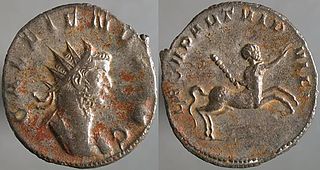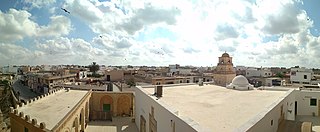The 230s decade ran from January 1, 230, to December 31, 239.
Year 238 (CCXXXVIII) was a common year starting on Monday of the Julian calendar. At the time, it was known as the Year of the Consulship of Pius and Pontianus. The denomination 238 for this year has been used since the early medieval period, when the Anno Domini calendar era became the prevalent method in Europe for naming years.

Gordian III was Roman emperor from 238 to 244. At the age of 13, he became the youngest sole emperor of the united Roman Empire. Gordian was the son of Antonia Gordiana and Junius Balbus, who died before 238. Antonia Gordiana was the daughter of Emperor Gordian I and younger sister of Emperor Gordian II. Very little is known of his early life before his acclamation. Gordian had assumed the name of his maternal great grandfather in 238.

Gordian I was Roman emperor for 22 days with his son Gordian II in 238, the Year of the Six Emperors. Caught up in a rebellion against the Emperor Maximinus Thrax, he was defeated by forces loyal to Maximinus, and he committed suicide after the death of his son.

Gordian II was Roman emperor with his father Gordian I in 238 AD, the Year of the Six Emperors. Seeking to overthrow Maximinus Thrax, he died in battle outside Carthage. Since he died before his father, Gordian II likely had the shortest reign of any Roman emperor, at 22 days, possibly second only to Quintillus, who, according to some sources, reigned for just 17 days.

Legio II Parthica was a legion of the Imperial Roman army founded in AD 197 by the emperor Septimius Severus, for his campaign against the Parthian Empire, hence the cognomenParthica. The legion was still active in the beginning of the 5th century. The legion's symbol was a centaur.

Decimus Caelius Calvinus Balbinus was Roman emperor with Pupienus for three months in 238, the Year of the Six Emperors.

Marcus Clodius Pupienus Maximus was Roman emperor with Balbinus for 99 days in 238, during the Year of the Six Emperors. The sources for this period are scant, and thus knowledge of the emperor is limited. In most contemporary texts he is referred to by his cognomen "Maximus" rather than by his second nomen Pupienus.
Herodian or Herodianus of Syria, sometimes referred to as "Herodian of Antioch", was a minor Roman civil servant who wrote a colourful history in Greek titled History of the Empire from the Death of Marcus in eight books covering the years 180 to 238. His work is not considered entirely reliable, although his less biased account of Elagabalus may be more useful than that of Cassius Dio. Herodian himself may have been a Syrian, though he appears to have lived for a considerable period of time in Rome, possibly without holding any public office. From his extant work, it seems that he was still living at an advanced age during the reign of Gordianus III, who ascended the throne in 238. Beyond this, nothing is known of his life.

Thysdrus was a Carthaginian town and Roman colony near present-day El Djem, Tunisia. Under the Romans, it was the center of olive oil production in the provinces of Africa and Byzacena and was quite prosperous. The surviving amphitheater is a World Heritage Site.

El Djem or El Jem is a town in Mahdia Governorate, Tunisia. Its population was 21,576 at the 2014 census. It is home to Roman remains, including the Amphitheatre of El Jem.
There are at least 6 major conflicts known as The Battle of Carthage. They are,

The Year of the Six Emperors was the year AD 238, during which six men made claims to be emperors of Rome. This was an early symptom of what historians now call the Crisis of the Third Century, also known as Military Anarchy or the Imperial Crisis, a period in which the Roman Empire nearly collapsed under the combined pressures of foreign invasions and migrations into the Roman territory, civil wars, peasant rebellions, political instability, Roman reliance on foreign mercenaries known as foederati and commanders nominally working for Rome, the devastating social and economic effects of the plague, debasement of currency, and economic depression. The crisis ended with the ascension of Diocletian and his implementation of reforms in 284.

Maximinus Thrax was a Roman emperor from 235 to 238. Born of Thracian origin – giving the nickname "Thrax" – he rose up through the military ranks, ultimately holding high command in the army of the Rhine under Emperor Severus Alexander. After Severus was murdered in 235, he was proclaimed emperor by the army, beginning the Crisis of the Third Century.
The Legio IV Italica was a legion of the Imperial Roman army raised in AD 231 by emperor Alexander Severus. The legion remained in existence as late as AD 400.
Vitalianus or Anglicized into Vitalian was a Praetorian Prefect during the reign of the Roman Emperor Maximinus Thrax. He is mainly notable for being assassinated in the course of the revolt by the Roman Senate on behalf of Gordian I and Gordian II, a step deemed necessary due to the terror he apparently instilled in the people of Rome in Maximinus' own absence. According to the historian Herodian, Vitalianus was killed by a group of soldiers who gained an audience with him on the pretext of carrying secret messages concerning Maximinus.
Capelianus was a Roman governor of the province of Numidia in the 3rd century, and commander of the army that defeated and killed Gordian II in 238, the Year of the Six Emperors.
The siege of Aquileia was a siege battle that took place in 238 in the town of Aquileia during the Year of the Six Emperors, which resulted in the assassination of Maximinus Thrax.

The Gordian dynasty, sometimes known as the Gordianic dynasty, was short-lived, ruling the Roman Empire from 238 to 244 AD. The dynasty achieved the throne in 238 AD, after Gordian I and his son Gordian II rose up against Emperor Maximinus Thrax and were proclaimed co-emperors by the Roman Senate. Gordian II was killed by the governor of Numidia, Capillianus and Gordian I killed himself shortly after, only 22 days after he was declared emperor. In 238, Pupienus and Balbinus, who were not of the Gordian dynasty, were declared co-emperors but the Senate was forced to make Gordian III a third co-emperor in 238, due to the demands of the Roman people. Maximinus attempted to invade Italy but he was killed by his own soldiers when his army became frustrated. After this, the Praetorian Guard killed Pupienus and Balbinus, leaving Gordian III as the sole emperor. Gordian III ruled until AD 244 when he was either killed after his betrayal by Philip the Arab, or killed at the Battle of Misiche; with his death, the dynasty was ended and Philip the Arab became emperor.









